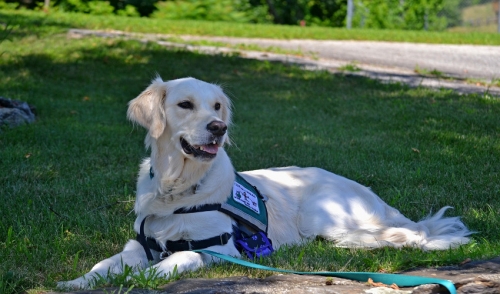{article.name}
How to Identify a Service Animal on Duty

- Share this:
- Share on Facebook
- Pin on Pinterest
- Tweet on Twitter
Dogs, cats, ferrets, ducks, parrots, miniature horses, monkeys and other animals may make amazing pets, but each of these animals – and many other species – can also be valuable service animals. But how can you tell when an animal is a vital helper instead of a pampered pet, and when that animal is on duty?
What Is a Service Animal?
A service animal is any animal, of any breed, size or species, that is specifically trained to offer assistance or perform tasks for a person with a disability. Depending on their training and the help they provide, these animals may also be called assistance animals, support animals or helper animals. The help they provide may be physical, such as guiding a person with vision loss, alerting a person with hearing loss or pushing buttons or grasping handles for individuals who have difficulty with fine motor skills. Animals may help with balance issues, open or close doors or fetch and carry items, or can be trained to sense the onset of seizures or even detect low blood sugar levels. Some animals even offer mental or emotional support to their partners, helping soothe anxiety, minimize panic attacks or reduce post traumatic stress disorder. No matter what assistance these animals provide, they are invaluable to their partners and are hard-working, dedicated companions.
Is This Service Animal Working?
It can be difficult to tell when a service animal is working, but in the broadest sense, no properly trained service animal is every completely off-duty. Because these animals provide critical services to keep their partners safe, they may be called upon to perform that service at any time. That doesn't mean they never get to relax, however, and their human partners take great care of their service animals, including giving them play time, proper grooming, a healthy diet and plenty of love.
A service animal needs to be alert to its partner at all times in case its help is needed. If an animal is out in public with its partner, it is on duty. If you aren't certain whether or not a service animal is working, there are good clues to watch for, such as…
- An animal wearing a brightly colored vest, badge, harness or bandana that designates the animal as a service animal or on duty. Many animals are trained that when they are wearing these accessories, they are on alert.
- An animal staying close to its partner, focusing on its human friend. Even if the animal is resting or appears relaxed, it will be alert to subtle signals that its help is required. A service animal on duty should not be distracted or strongly focused on anything but its partner.
- Performing an unusual task, with its human partner responding to the clues the animal provides. This interaction may only be brief, but there is an unmistakable bond between the individual and their assistance animal as they work together.
It is important to note that there is no requirement that service animals need to wear specific gear to identify themselves, nor do they need to have identification or papers confirming their designation as service animals. Some states and countries have laws that individuals can be prosecuted for harassment, reckless behavior, endangerment or other crimes if they interfere with or distract service animals in any way that may jeopardize the animals' duties or put their human partners at risk. Laws vary in different areas, but if you are aware that service animals are always on duty and needed by their partners, you won't forget to treat the animals with proper respect so they can offer the help they're trained to give.
*My vary depending on what state you live in*
Special Offers

We offer FREE home delivery—no minimum purchase required! ( Print This )
Company Events
We currently do not have any events scheduled.

Comments